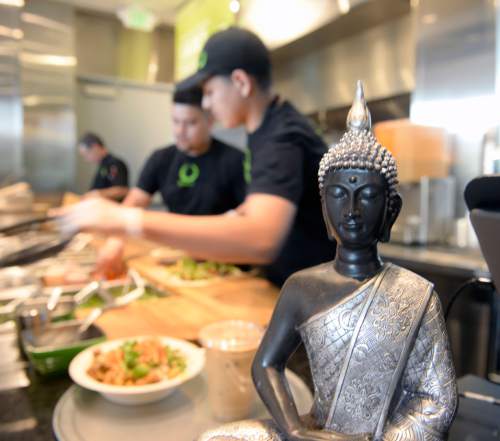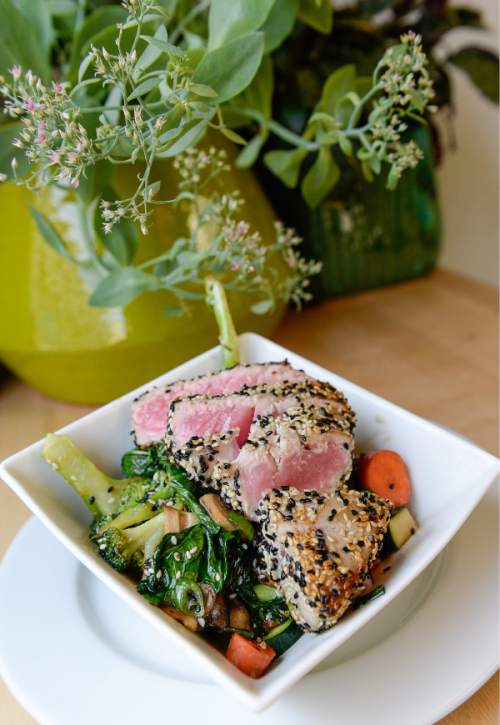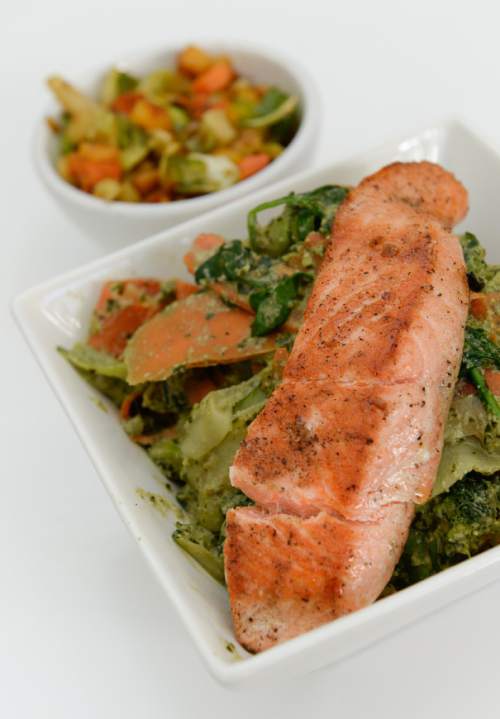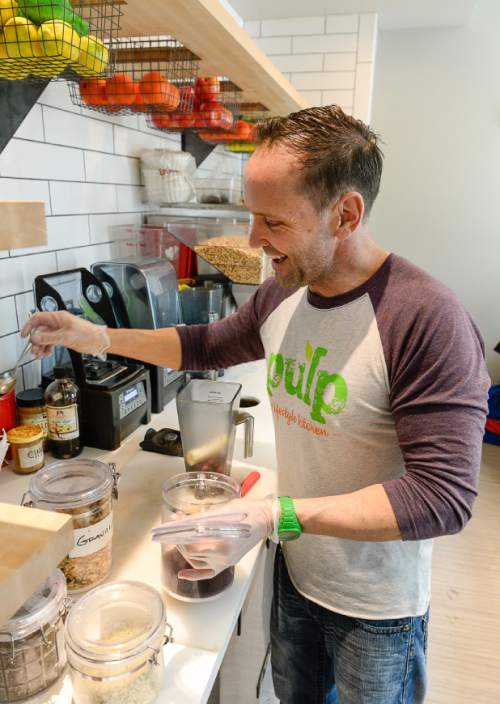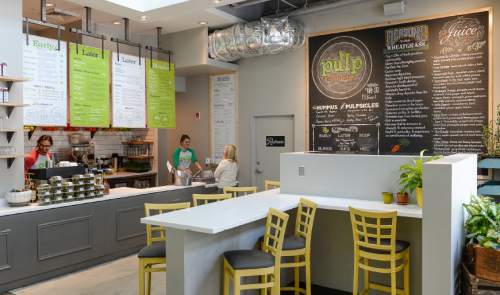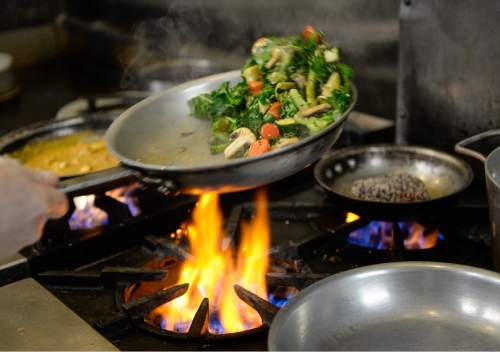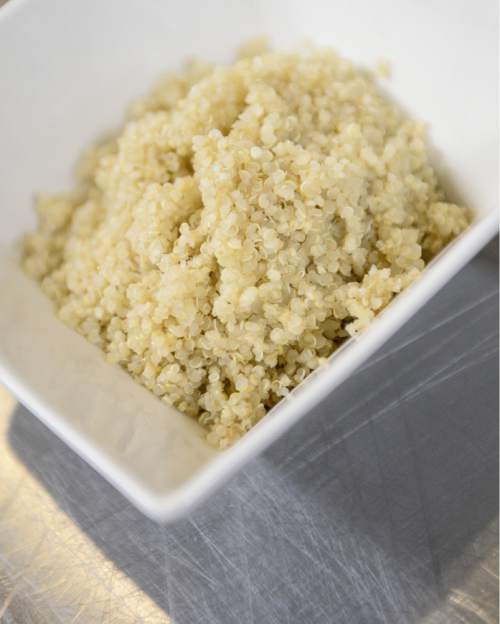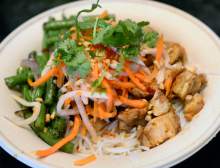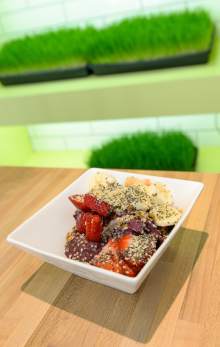This is an archived article that was published on sltrib.com in 2016, and information in the article may be outdated. It is provided only for personal research purposes and may not be reprinted.
Bowls are moving up in the culinary standings.
Today, the humble eating vessel is just as likely to hold layers of healthy grains, vegetables and proteins as it is cereal or soup.
These "super bowls" are a twist on the traditional Japanese rice bowl and can be found in all sorts of bistros, cafes and quick-serve restaurants whether the menu is themed Asian or American, Middle Eastern or Mexican.
Grain bowls have "really caught on with diners," said Thomas Kreitlow, owner of Pulp Lifestyle Kitchen, one of several Utah restaurants where healthy bowls are on the menu.
A greater interest in healthy eating, while maintaining convenience, is much of the reason, said Kreitlow, who opened Pulp about six months ago on Salt Lake City's Gallivan Avenue. The menu also includes smoothies, sandwiches and soup.
When building a grain bowl, Kreitlow said, start with a healthy base. Brown rice, quinoa and noodles are the most common, but recipes can include other healthy grains such as barley, bulgur and farro.
Top the base with vegetables — think carrots, broccoli, zucchini, kale, spinach and mushrooms. Use at least 1 cup per serving, but 2 cups is better.
The final layer is a lean protein such as grilled ahi tuna or salmon, chicken, tofu or even a fried egg.
Don't forget to enhance this meal-in-a-bowl with a sauce or pesto and garnish it with chopped herbs or ground nuts.
At Pulp, the bowl offerings span the globe. There is the Asian-inspired Uma bowl, where grains and vegetables are flavored with a sweet chile-ginger sauce. There also are the Indian-inspired Chika bowl made with tikka masala and cashew cream and the Latin Sano bowl with corn, black beans, avocado and cotija cheese.
At home, bowls are an especially good vehicle for using leftovers, and they can be built quickly on busy weeknights if you remember to cut the vegetables and cook the grains in advance, Kreitlow said.
And because they can be customized, it's easy to build a bowl that suits the tastes of young children and picky eaters.
Super bowls aren't just for lunch and dinner. At the Protein Foundry Health Bar in Cottonwood Heights, the bowls are a popular breakfast item, said Lorin Warner, co-owner with Jared Brockton.
The restaurant, which opened about two months ago, specializes in açai bowls, made from the nutrient-rich purple berries native to Brazil. The berries are shipped frozen and when blended look like thick ice cream. The mixture is served in a bowl with fresh fruit and granola. Protein Foundry also has Greek yogurt bowls and pitaya, or dragon fruit, bowls.
"There's just something about a bowl that makes things easy to eat," said Warner, who lived in Brazil for many years. "You don't have to cut things up or worry about it falling out."
While Zao Asian Café, a fast-casual restaurant in Salt Lake City, serves sandwiches, tacos and salads, it's the rice and noodle bowls that are most popular, said chef Mark Benson. "When we first opened we weren't sure if the bowls were going to a big seller, but they are 60 percent of sales."
Unlike tacos and sandwiches, bowls are one of the few foods that can be reheated the next day with minimal problems, he said, adding that depending on the day, ordering a bowl "is just as fast — and maybe faster — than the drive-up window where you get a 2,000-calorie meal."
kathys@sltrib.com
—
Salmon and citrus rice bowl
4 navel oranges
1/4 ounce (1-inch piece) fresh ginger, peeled and thinly sliced, plus 1 teaspoon finely grated
1 dried bay leaf
1 teaspoon coriander seeds, crushed
1 tablespoon brown-rice vinegar
1 teaspoon low-sodium soy sauce
1 teaspoon honey
1 teaspoon toasted sesame oil
1 pound skinless salmon fillets
1 cup uncooked brown rice
1 1/2 cups (5 ounces) sugar snap peas, cut into 1/2-inch pieces
1/4 cup fresh mint, thinly sliced, for garnish
2 teaspoons black sesame seeds, for garnish
Cut away peel and pith from 2 oranges. Cut between orange membranes, and let fruit and juice fall into a bowl. Squeeze juice into bowl, and discard membranes. Cut segments into small pieces, and place in a separate bowl. Juice remaining 2 oranges, and add to juice in bowl (for a total of 1 cup).
Bring orange juice, sliced ginger, bay leaf and coriander to a boil in a small saucepan. Cook until mixture is reduced to 2/3 cup, about 6 minutes. Cool completely. Strain, and whisk in vinegar, soy sauce, honey and oil.
Combine 3 tablespoons juice mixture and salmon in a resealable plastic bag, turning to coat. Refrigerate salmon and remaining juice mixture for at least 1 1/2 hours (or up to 3 hours).
Cook rice according to package instructions.
Preheat broiler. Remove salmon from marinade, and pat dry with paper towels. Discard marinade. Place fillets on a baking sheet, and broil until cooked to desired doneness, about 5 minutes for medium. Transfer to a dish. Let salmon cool slightly, and flake into bite-size pieces.
Divide rice among 4 bowls. Top with salmon, peas, and orange segments. Garnish with mint and sesame seeds. Drizzle each serving with 1 1/2 tablespoons of the reserved juice mixture.
Servings • 4
Source: marthastewart.com
—
Salmon and citrus rice bowl
4 navel oranges
¼ ounce (1-inch piece) fresh ginger, peeled and thinly sliced, plus 1 teaspoon finely grated
1 dried bay leaf
1 teaspoon coriander seeds, crushed
1 tablespoon brown-rice vinegar
1 teaspoon low-sodium soy sauce
1 teaspoon honey
1 teaspoon toasted sesame oil
1 pound skinless salmon fillets
1 cup uncooked brown rice
1 ½ cups (5 ounces) sugar snap peas, cut into ½-inch pieces
¼ cup fresh mint, thinly sliced, for garnish
2 teaspoons black sesame seeds, for garnish
Cut away peel and pith from 2 oranges. Cut between orange membranes, and let fruit and juice fall into a bowl. Squeeze juice into bowl, and discard membranes. Cut segments into small pieces, and place in a separate bowl. Juice remaining 2 oranges, and add to juice in bowl (for a total of 1 cup).
Bring orange juice, sliced ginger, bay leaf and coriander to a boil in a small saucepan. Cook until mixture is reduced to 2/3 cup, about 6 minutes. Cool completely. Strain, and whisk in vinegar, soy sauce, honey and oil.
Combine 3 tablespoons juice mixture and salmon in a resealable plastic bag, turning to coat. Refrigerate salmon and remaining juice mixture for at least 1 ½ hours (or up to 3 hours).
Cook rice according to package instructions.
Preheat broiler. Remove salmon from marinade, and pat dry with paper towels. Discard marinade. Place fillets on a baking sheet, and broil until cooked to desired doneness, about 5 minutes for medium. Transfer to a dish. Let salmon cool slightly, and flake into bite-size pieces.
Divide rice among 4 bowls. Top with salmon, peas and orange segments. Garnish with mint and sesame seeds. Drizzle each serving with 1 ½ tablespoons of the reserved juice mixture.
Servings • 4
Source: marthastewart.com


